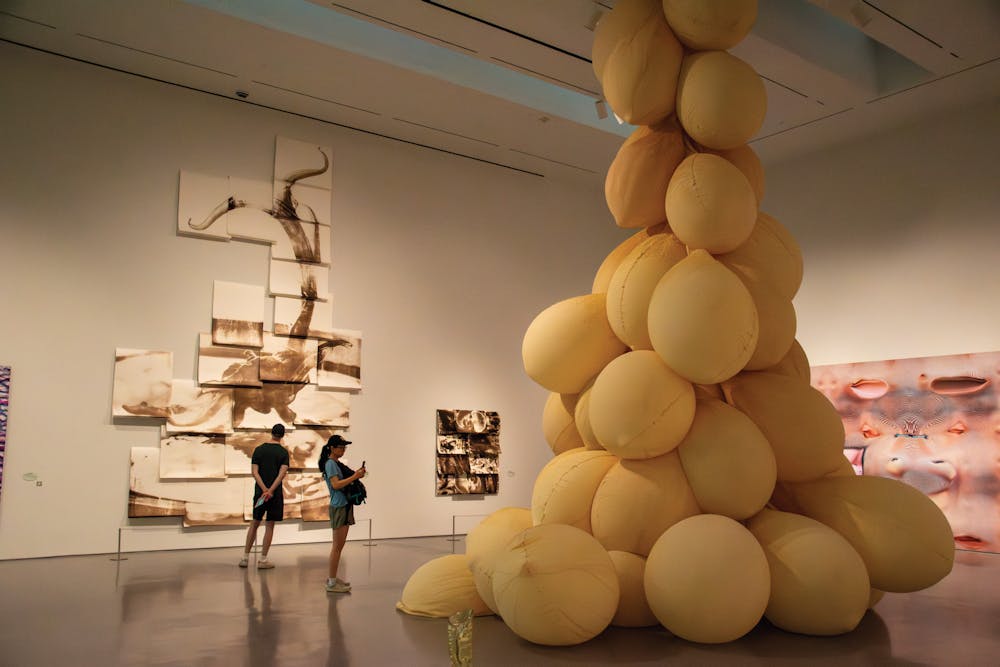Moody Center’s new exhibit blurs the line between body and machine

Eva Fabregas’ latex formations will be on view as part of the Moody Center for the Arts’ newest exhibition “Bio Morphe,” on view from Sept. 5 to Dec. 20, 2025. Lucy Li / Thresher
Swelling latex sculptures, inspired by placentas and umbilical cords have taken up residence in the Moody Center for the Arts. The Barcelona-based artist Eva Fàbregas describes her pieces as forms that grow from “the guts of the architecture,” inflating and wrinkling as if they were alive.
The Moody Center’s fall exhibition, “Bio Morphe,” opens a conversation between the human body and the natural world through seven artists working at the edge of science, craft and technology. Curated by Frauke V. Josenhans, the show explores biomorphism — patterns and forms inspired by living systems — and asks how contemporary materials and processes change the way we see ourselves.
“Everything’s in movement,” Josenhans said during a walkthrough of the exhibition. “So we move from one space to the next.”
In the central gallery, Fàbregas presents three large-scale sculptures from her series on metabolic processes that appear to seep from the architecture. Fàbregas built each form by marrying elastic fabric and latex, then shaping them with air.
“I put [air] there and I take it out, and that’s how all these wrinkles begin to appear,” Fàbregas said. “So it’s like a breathing process … I make them inhale and exhale for the first time.”
For Fàbregas, latex itself is part of the story.
“Latex is also an excavation of a tree,” she said. “It’s the rubber that comes from a tree when it has a wound, it’s a material that never is stable, and it’s always changing and transforming … After they leave the studio, they have a livelihood of their own.”
Across the room, Lucy Kim bridges painting, photography and biotechnology. Trained as a painter, Kim casts real surfaces — like a beach at low tide — then paints imagery atop those undulating forms. Her other works in the exhibition use a lab-based screenprinting process with genetically modified bacteria that produce melanin directly on paper.
“I don’t actually print any melanin — I print the bacteria,” Kim said. “Over three days, while it’s incubating in a temperature and moisture-controlled environment, the bacteria slowly [make] the melanin … the image is, in fact, at one point, alive.”
One print enlarges an albino vanilla plant Kim photographed while researching gene-edited agriculture near Miami. Another overlays orchid patterns to show how living processes subtly alter images over time.
“When they’re photographed, it confuses people … to see the work in person, its reality is different than a 2D image,” Kim said. “It’s not sculpture, it’s not a flat painting or a photograph. It’s somewhere in between.”
Working with brightly dyed industrial cable ties, New York-based artist Sui Park built forms that seem to pulse with cellular life. Park dyed and weaved thousands of ties by hand, snapping them together into freestanding volumes without internal armatures.
“I considered each cable tie like structural [forms that] can be architecture modules or cells,” Park said. “They are very flexible but very strong.”
Park said she prefers viewers to bring their own associations to her work.
“I don’t have any specific imagination that I give [the] audience,” she said. “They can have … very different or innovative thinking with my work. I just want [the] audience to have their own experience.”
The exhibition links today’s artists to those who came before them. Louise Bourgeois’ sculpture “The Couple” provides a historic touchstone, while Berenice Olmedo’s prosthetic-inspired forms, Tishan Hsu’s screen-like surfaces and Christina Quarles’ fluid bodies carry the conversation into the present.
Even the galleries participate. The exhibition graphics by Omnivore, Inc. echo the show’s organic vocabulary with biomorphic label shapes and a moss-textured title wall.
“They did a really fantastic work, responding to the artwork and exhibition and embracing the concept of biomorphism,” Josenhans said.
By the time visitors loop back to the entrance, the exhibition’s premise has unfolded materially: living processes translated into elastic membranes, bacterial pigments, industrial plastics and historical forms — all shifting as we look.
“These structures … are never stable,” Fàbregas said. ”They are always in constant transformation.”
“Bio Morphe” is open Sept. 5 to Dec. 20 at the Moody Center for the Arts.
More from The Rice Thresher

Rice loses to UH in Bayou Bucket Classic
The Bayou Bucket will remain with the University of Houston until at least 2030 after Rice football lost to the Cougars Saturday.

Fizz users and moderators talk fame, challenges
During the volleyball team’s face-off against the University of Texas at Austin on Sept. 3, Jack Vu decided to have a little fun with the scoreboard. An anonymous poster had inaccurately mentioned that Rice beat UT on Fizz, so Vu decided to join in.

New fiction course allows writers to incorporate and “resist” AI influence
Rice is bringing generative artificial intelligence into the creative writing world with this fall’s new course, “ENGL 306: AI Fictions.” Ian Schimmel, an associate teaching professor in the English and creative writing department, said he teaches the course to help students think critically about technology and consider the ways that AI models could be used in the creative processes of fiction writing.

Please note All comments are eligible for publication by The Rice Thresher.